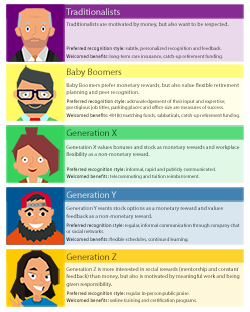What Motivates Your Workers? It Depends on Their Generation
Motivating several generations of employees requires targeted encouragement

Five generations work side by side in today’s workforce, making it important to create an inclusive culture that meets the varying needs of each age group, according to a new research paper.
Members of each generation bring a distinct set of values, attitudes and behaviors to the workplace, noted Kimberly Abel-Lanier, vice president and general manager of workforce solutions for St. Louis-based Maritz Motivation Solutions, an employee recognition provider.
“The multigenerational workforce requires flexible leadership, policies and programs,” she wrote in her paper, 8 Ways to Motivate the Five-Generation Workforce. “Today’s leaders must familiarize themselves with the perspectives, needs and influences of each generation.”
That’s especially important with “seismic” generational shifts in the workplace projected to occur by 2020, Abel-Lanier said during a May 3 webinar on the topic. She pointed to a 2014 global study by Oxford Economics that forecast:
- Traditionalists, those born 1928-45, are expected to drop from 3 percent of the workforce in 2015 to 1 percent in 2020.
- Baby Boomers, those born 1946-64, are expected to drop from 31 percent of the workforce in 2015 to 22 percent in 2020 (nearly 70 million are expected to retire by that time).
- Generation X, those born 1965-79, is expected to drop from 21 percent of the workforce in 2015 to 20 percent in 2020.
- Generation Y (also known as the Millennial generation), those born 1980-95, is expected to increase from 45 percent of the workforce in 2015 to 50 percent in 2020.
- Generation Z (also known as the Globals or the Gamer generation), those born 1996 and later, is expected to increase from 1 percent of the workforce in 2015 to 7 percent in 2020.
What the Generations Value
Abel-Lanier advised organizations to reinvent and customize their recognition strategy by considering the following motivation and recognition preferences of the different generations:
- Traditionalists are motivated by money but also want to be respected. They want to make an impact and continue to add value to society and the organization, she said during the webinar. This group typically prefers milestone recognitions and values flexible schedules and promotions.
Preferred recognition style: subtle, personalized recognition and feedback.
Welcomed benefits: long-term care insurance, catch-up retirement funding. - Baby Boomers, like Traditionalists, prefer monetary rewards but also value nonmonetary rewards such as flexible retirement planning and peer recognition. They do not require constant feedback, having an “all is well unless you say something” mindset, Abel-Lanier pointed out in her paper. This is an ambitious, goal-oriented generation that is motivated by promotions, professional development, a desire to be in a position of authority, and having their expertise valued and acknowledged. They prefer recognition from their peers rather than their supervisors, she said.
Preferred recognition style: acknowledgement of their input and expertise; prestigious job titles and parking places and office size are measures of success for this group.
Welcomed benefits: 401(k) matching funds, sabbaticals, catch-up retirement funding. - Generation X members value bonuses and stock as monetary rewards and flexibility as a nonmonetary reward. This generation prefers to work independently and believes career progression should be based on competence, not rank, age or seniority in the job. The type of rewards they favor are recognition from the boss, gift cards, experiential rewards and flexible schedules.
Preferred recognition style: informal, rapid and publicly communicated.
Welcomed benefits: telecommuting and tuition reimbursement. - Generation Y wants stock options as a monetary reward and values feedback as a nonmonetary reward. Members of this generation are motivated by skills training, mentoring, feedback and the workplace culture. They respond to recognition from the boss, time off and flexible schedules as rewards.
Preferred recognition style: regular, informal communication through company chat or social networks.
Welcomed benefits: flexible schedules, continued learning.
- Generation Z is more interested in social rewards—mentorship and constant feedback—than money, but this generation also is motivated by meaningful work and being given responsibility. They want to know how their work impacts the organization and their role in the organization’s big picture, Abel-Lanier said.
“They want exciting projects they can be passionate about,” she said. Additionally, “more than any other generation, Gen Z will challenge businesses to think about their operational model.” This also is the most tech-savvy of the generations. “If we thought Millennials [Generation Y] were multitaskers, this group is multitaskers on steroids,” and members typically are plugged into five devices at once.
The rewards they prefer include recognition from the boss, experiential rewards and badges such as those earned in gaming. Members of this generation expect workplace flexibility and diversity.
Preferred recognition style: regular in-person public praise.
Welcomed benefits: online training and certification programs.
8 Tips for Motivating the Different Generations
Abel-Lanier recommended the following ways to motivate a multigenerational workforce:
- Promote collaboration and celebration. Consider investing in online platforms where employees can share their successes.
- Managers should seek to understand individual work styles and how people like to be recognized for accomplishments.
- Make the customer the mutual priority. This has everyone working together on a common purpose.
- Enable personal growth and work/life balance. This is something all generations appreciate.
- Develop employee strengths through a mentorship program. Start a reverse mentorship program in which each employee is both a mentor and a mentee.
- Define culture in a way that can be explained to everyone, and survey employees at all levels of your organization to get a 360-degree view of the culture.
- Carefully select managers based on experience, aptitude, capacity for growth, leadership style, and understanding of organizational and employee challenges and opportunities.
- Enhance employees’ well-being. Wellness, performance management and employer branding are three programs that integrate seamlessly with recognition initiatives and offer added value.
Kathy Gurchiek is the associate editor of HR News. Follow her @SHRMwriter.
Advertisement
An organization run by AI is not a futuristic concept. Such technology is already a part of many workplaces and will continue to shape the labor market and HR. Here's how employers and employees can successfully manage generative AI and other AI-powered systems.
Advertisement



